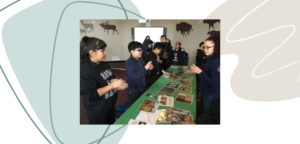Navigating Inquiry-Based Instruction

To view the photo-rich magazine version, click here.
Originally appears in the Spring 2022 issue.
By Pamela Chin
Walking into a 21st-century classroom today is a very different experience from walking into the classrooms of the past. Cultural backgrounds, mindsets, life experiences, languages, and attention spans of the current generation of students are more varied from those of preceding generations. Therefore, the structure, facilitation, and teaching of the students in these classrooms should be adjusted in order to remain effective. Since the 1960s, direct instruction has been proven to be an effective means of educating students, but [1] in recent decades, inquiry-based instruction has been introduced as an alternative. The inquiry-based approach can come in many different forms, but an increasingly popular one is project-based learning. Project-based learning is student-driven and allows students to independently explore and build their own knowledge through personal discovery and investigation.[2] In contrast, traditional approaches to instruction, like direct instruction, can be much more efficient when concepts and skills are taught with the goal that students need to master a certain level of knowledge in order to move to the next level and learn new concepts and skills.[1]
Which is more effective?
So where does this leave us? Even though previous studies differ in their conclusions regarding whether traditional or inquiry-based instruction is more effective, there are studies that also make strong cases that problem-based learning and inquiry approaches are the best ways to prepare students to be strong contenders for the 21st-century workforce.[3] Educators and researchers across the board agree that certain competencies are needed in order for students today to be able to compete in our increasingly globalized, competitive world.[4] According to the National Education Association, the “Four Cs” of critical thinking, communication, collaboration, and creativity are needed to support student success in the future.[5]
In following with this, I compared different units of study about the environment and environmental issues from different curricula to discover how each curriculum — using either inquiry and direct-based approaches — equipped teachers to have their students learn and practice the “Four Cs” as well as problem solving. The inquiry-based curricula include a more balanced collection of features that have built-in support for teachers to facilitate 21st-century learning.[6] These inquiry-based curricula have more activities that naturally provide teachers with ways of supporting foundational skills like critical thinking and communication as well as next-level skills like collaboration, creativity, and problem solving — all imperative to thriving in the 21st century.[6]
After reviewing different studies on the effectiveness of direct or inquiry-based approaches, I found that both techniques yielded positive, negative, and neutral outcomes. This suggests that there may not be one instructional approach that is most effective for every student population.[6] However, educators should consider whether or not the curriculum they use includes a balance of 21st-century skills and learning in its framework. They may ask, will this curriculum support students in becoming equally effective as independent critical thinkers, communicators of their ideas with others (in speech and in writing), and creative collaborators who can work toward a goal and solve problems? Until direct instruction becomes more balanced, inquiry-based learning curricula have more 21st-century learning skills and practices built into their frameworks and may be more effective for preparing the next generation of learners. When debating between which approach would be best for their population of students, teachers, schools and administrators could consider a blend of direct and inquiry-based instruction.[6] Additionally, teachers using English Language Arts curricula need to be proactive about how they can better incorporate a balance of 21st-century learning skills into their lessons so that their teaching doesn’t just become direct instruction, especially when dealing with the topic of the environment, which has great potential for exploration, inquiry, and discovery.[6]
Instructional context
The different components of the following lessons have been tested out in different pieces over the years and were originally created for integrated co-teaching (ICT) 7th-grade, English Language Arts (ELA), in-person classes, but they can be adapted for different grade levels and — although not the focus of this article — for remote learning. The following learning sequence is part of a larger argument-focused unit called “People and the Planet” with the essential question of what impacts do people have on the environment? This particular part of the unit focuses specifically on humanity’s impact on animal species and whether zoological institutions like zoos and animal parks truly serve to benefit animals and conservation efforts. In this way, students will be focusing specifically on using different persuasive techniques to argue the ethics of keeping animals in human care — whether humans have a more positive or negative impact on supporting our planet’s biodiversity through the use of zoos and animal parks. Woven into the framework of these ELA-focused lessons are different opportunities for students to engage in the “Four Cs.”[5] Lastly, each session can be split to accommodate classes that may need more time to dive deeper into certain concepts.

ELA inquiry-based mini-unit lesson plan outlines: Weighing the pros and cons of animals in human care
Through this ELA inquiry-based investigation, consider the balance and flow of the “Four Cs” through each session.
Overall mini-unit learning target
I can determine whether the benefits of keeping animals in human care outweigh the costs.
The flow of student goals
Students will be able to…
- Session 1 – Build knowledge about persuasive techniques (Collaboration, Critical Thinking): Students will gain background knowledge about different persuasive techniques in ads, videos, and writing in order to frame their research from an unbiased perspective.
- Session 2 – Research (Critical Thinking, Collaboration): Students will gather evidence and determine the benefits and costs of keeping animals in human care through inquiry-based zoo exploration and viewing/reading media and text sources.
- Session 3 – Discuss (Communication): Students will engage in a Socratic seminar/Fishbowl discussion about the costs versus benefits of keeping animals in human care.
- Session 4 – Create and take a stand (Creativity, Critical Thinking, & Collaboration): Students can be grouped according to their stance and product choices. They can choose to design/direct a Powtoon, Brainpop, or Flipgrid video or write a persuasive letter or essay that either 1) conveys their stance and potential solutions (sent to a city or state representative like Senator Cathleen Galgiani, either in support or opposition of her bill to ban dolphins from being held in human care) OR 2) conveys their stance about animals in human care (sent to a local zoological institution).

Click here for printable versions of the activities.
Pamela Chin is a middle school English Language Arts teacher in New York City. With the goal of more effectively incorporating her personal passion for sustainability and conservation into her classroom, she is working toward a Master of Arts in Teaching in the Biological Sciences with the Advanced Inquiry Program, a partnership between Miami University’s Dragonfly program and the Wildlife Conservation Society. She hopes to provide more opportunities for educators and students to engage in authentic, interdisciplinary learning through an inquiry-based approach as they work toward sustainable solutions to environmental issues in the local communities in and around New York City. She fell in love with the natural world upon visiting the Grand Canyon as a kid and then trekking through many more national parks as an adult. She hopes to share this love of our planet with her students and foster a curiosity for natural discovery every day.
References:
[1] Jean Stockard et al. “The Effectiveness of Direct Instruction Curricula: A Meta-Analysis of a Half Century of Research,” Review of Educational Research 88, no. 4 (2018): 479–507, doi:10.3102/0034654317751919.
[2] Sarah A. Johnson et al. “The Effects of Inquiry Project-Based Learning on Student Reading Motivation and Student Perceptions of Inquiry Learning Processes,” Georgia Educational Researcher 13, no. 1 (2016): 51–85, doi:10.20429/ger.2016.130102.
[3] Patricia Bills et al. “Lessons from the field: One teacher’s findings from using the project approach in a 6th grade classroom,” Middle School Journal 49, no. 2 (2018): 24–35, doi:10.1080/00940771.2017.1413842.
[4] Ken Kay. “Middle Schools Preparing Young People for 21st Century Life and Work,” Middle School Journal 40, no. 5 (2009): 41–45, doi:10.1080/00940771.2009.11461691.
[5] “An Educator’s Guide to the “Four Cs”,” National Education Association, n.d., Retrieved from https://www.aledoisd.org/cms/lib/TX02205721/Centricity/Domain/2020/Preparing21C_Learners.pdf
[6] Pamela Chin, “Cultivating 21st Century Learning through Curricula about the Environment” (BIO 654 E Inquiry Project Paper, Miami University, 2019).
[7] Blackfish, directed by Gabriela Cowperthwaite (2013; Magnolia Pictures and CNN Films), Film. [Film].
[8] Escape from Extinction, directed by Matthew R. Brady (2021; GravitasVOD), Film.
[9] Merriam-Webster. “Documentary.” Accessed March 14, 2021, https://www.merriam-webster.com/dictionary/documentary
Footnotes:
i. Persuasive Techniques: https://resources.finalsite.net/images/v1585076084/chinaspringisdnet/hgtvmoxcat66z4r8fzi1/Notes1ArtofPersuasiondocx.pdf
ii. Jigsaw Protocol: https://curriculum.eleducation.org/sites/default/files/curriculumtools_classroomprotocols_053017.pdf
iii. Stations Protocol: https://practices.learningaccelerator.org/problem-of-practice/how-do-i-set-up-a-station-rotation-model-in-my-classroom
iv. NewsELA: Issues Overview – Should we have zoos? Article https://newsela.com/read/overview-zoos/id/28236/?collection_id=2000000156
v. Video: Above the Noise (PBS): Are Zoos Good or Bad for Animals?: https://www.pbs.org/video/are-zoos-good-or-bad-for-animals-xiuhd7/
vi. Video: Are Zoos Good or Bad? New Documentary Uncovers the Truth: https://thenewdaily.com.au/entertainment/tv/2017/01/10/are-zoos-good-or-bad/
vii. California Globe: Dolphins Would Join Orcas in New Captivity Ban Bill: https://californiaglobe.com/section-2/dolphins-would-join-orcas-in-new-captivity-ban-bill/
viii. NewsELA: Growing debate over whales and dolphins in captivity: https://newsela.com/read/captive-whales/id/5405/?collection_id=339&search_id=4983ac91-4d91-47d7-8ea1-3d769d461fff
ix. CNN: What ‘Blackfish’ left on the cutting room floor: https://www.cnn.com/2014/02/09/opinion/marilee-menard-blackfish-marine-parks
x. San Antonio Express-News: Ex-SeaWorld trainers dispute ‘Blackfish,’ say phase out whale show: https://www.mysanantonio.com/news/local/article/Ex-SeaWorld-trainers-dispute-Blackfish-say-5145648.php
xi. Wildlife Conservation Society/Bronx Zoo (New York): https://bronxzoo.com/
xii. Dartmoor Zoo (England): https://www.dartmoorzoo.org.uk/ourstory/
xiii. National Geographic: https://www.nationalgeographic.org/encyclopedia/zoo/
xiv. Fishbowl Protocol: https://curriculum.eleducation.org/sites/default/files/curriculumtools_classroomprotocols_053017.pdf





